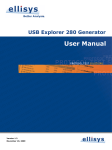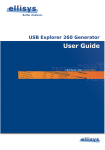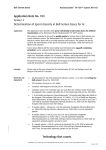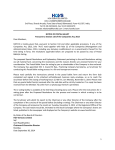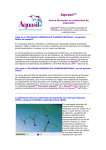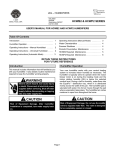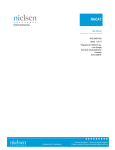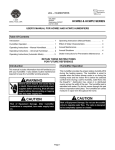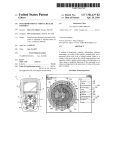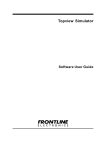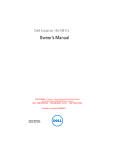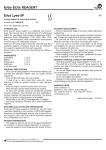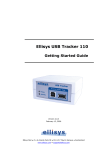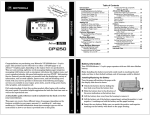Download r` ,
Transcript
US008095698B2 (12) United States Patent (10) Patent N0.: (45) Date of Patent: Santhanam et a1. (54) CIRCUITS AND METHODS FOR RELIABLE W0 (75) Inventors: Gopal Santhanam, Sunnyvale, CA (US); Kumaran Santhanam, Sunnyvale, CA (U S); Etai Bruhis, Palo Alto, CA (US) WO 2007092997 A1 * 8/2007 OTHER PUBLICATIONS Catalyst Enterprises Inc., “Conquest Series USB Protocol Analyz ers,” product speci?cation, 2006, entire document relevant. Catalyst Enterprises Inc ., “Bus & Protocol Analyzers,” product speci ?cation, 2005, entire document relevant. (73) Assignee: Total Phase, Inc., Sunnyvale, CA (US) Notice: Jan. 10, 2012 FOREIGN PATENT DOCUMENTS AUTOMATIC USB SPEED DETECTION (*) US 8,095,698 B2 Catalyst Enterprises Inc., “USB 1.x/2.0 Analyzer Exerciser Tester,” product speci?cation, entire document relevant. Ellisys, “Ellisys USB Explorer 260 Getting Started Guide,” manual, Subject to any disclaimer, the term of this patent is extended or adjusted under 35 Nov. 22, 2007, entire document relevant. U.S.C. 154(b) by 88 days. Ellisys, “Ellisys USB Explorer 200 Getting Started Guide,” manual, Feb. 13, 2006, entire document relevant. (21) App1.No.: 12/544,219 Finisar Corporation, “Bus DoctorTM RX Analyzer,” product speci? (22) Filed: cation, entire document relevant. Hitex, “USB Agent Explores the secrets of USB,” brochure, Jun. 2001, entire document relevant. Aug. 19, 2009 (65) Prior Publication Data US 2010/0049880 A1 (Continued) Feb. 25, 2010 Primary Examiner * Eron J Sorrell Related US. Application Data (74) Attorney, Agent, or Firm * Van Pelt, Yi & James LLP (60) Provisional application No. 61/090,223, ?led on Aug. 19, 2008. (51) Int. Cl. G06F 3/00 (57) The Universal Serial Bus (“USB”) 2.0 Speci?cation de?nes three speeds of communication for its bus, and each has its oWn signaling characteristics. Due to the uniqueness of each speed, PHYs must be placed in a separate mode for each signaling rate. Although USB devices may knoW its commu nication speed, a general purpose USB analyzer must be able to analyze all USB communications. Rather than force the user to manually set the operating mode of the analyzer, this invention describes circuits for automatically and reliably determining the monitored USB communication speed. (2006.01) (52) US. Cl. ....................................................... .. 710/15 (58) Field of Classi?cation Search ...................... .. None See application ?le for complete search history. (56) References Cited U.S. PATENT DOCUMENTS 7,139,344 B2 * 11/2006 Crutch?eld et a1. ........ .. 375/354 2003/0223486 A1* 12/2003 Hsu ................ .. 2008/0140885 A1* 6/2008 Collins 2009/0222685 A1* 9/2009 .. 375/224 710/67 28 Claims, 7 Drawing Sheets Foster et al. ................ .. 713/500 PHY Control Signals 20 r’ 1 ABSTRACT , K54 HS Capable PHY Packet Information USB Data Lines 22 7 r.) Logic Transceiver Signals 7 FS Transceiver Speed Detection US 8,095,698 B2 Page 2 OTHER PUBLICATIONS LeCroy Corporation, “LeCroy AdvisorTM USB 2.0 Bus and Protocol Analyzer User Manual,” user manual, Jul. 2007, entire document relevant. LeCroy Corporation, “LeCroy USBMobileHSTM Protocol Analyzer User Manual,” user manual, Jul. 2007, entire document relevant. LeCroy Corporation, “LeCroy USBTracerTM USB 2.0 Design & Veri?cation System User Manual,” user manual, Jul. 2007, entire document relevant. Author Unknown, “Universal Serial Bus Speci?cation,” speci?ca tion, Apr. 27, 2000, entire document relevant. * cited by examiner US. Patent Jan. 10, 2012 Sheet 1 of7 US 8,095,698 B2 Nw 62839m2. 2W/my?5H\89:5 .3‘ 609i Lmwbcd‘ :2BE:2.2“. US. Patent Jan. 10, 2012 Sheet 2 of7 Signal D+ US 8,095,698 B2 D Low-speed (1.5 Mbps, 3.3V) J O 1 K 1 0 SE0 0 O SE1 1 1 Full-speed (12 Mbps, 3.3V) J 1 O K O 1 SE0 0 O SE1 1 1 High-speed (480 Mbps, 400 mV) J 1 O K O 1 SE0 0 O SE1 1 1 Fig. 1b US. Patent Jan. 10, 2012 Sheet 3 of7 US 8,095,698 B2 1 6289;. >62:918506 289m N.5 a 1 mEwwcDaj US. Patent Jan. 10, 2012 Sheet 4 of7 US 8,095,698 B2 Reset FS SYNC Detected 3.3V SEO 225 ns HS Capture Mode FS Capture Mode LS Capture * 3.3V SEO FS K 225 ns 333 ns LS-over-FS Packet Completed Capture Mode or * FS J for ~3 us Fig. 3 Mode US. Patent Jan. 10, 2012 905,; Sheet 5 of7 US 8,095,698 B2 205 ,; w.5 US. Patent Jan. 10, 2012 Sheet 6 of7 US 8,095,698 B2 Reset or Timeout FSJ FS K 83 ns K1 Detected J1 Detected FS J / FS SYNC DETECTED FS K 83 ns ~FS J / ~FS SYNC DETECTED J2 Detected FS SEO SEO Detected Fig. 5 K2 Detected US. Patent Jan. 10, 2012 Sheet 7 of7 Host Psi US 8,095,698 B2 Host LS-over-FSi FS Hub LS-over-FS Fig. 6 US 8,095,698 B2 1 2 CIRCUITS AND METHODS FOR RELIABLE AUTOMATIC USB SPEED DETECTION traf?c are disclosed, comprising of a ?rst receiver for receiv ing USB traf?c; and a second receiver for receiving USB traf?c; Wherein the ?rst receiver and the second receiver are placed in parallel in receiving the USB traf?c; and Wherein CROSS REFERENCE the ?rst receiver may be a high-speed capable receiver and the second receiver may be a full-speed receiver. The signaling mode may be detected by the ?rst receiver and the second receiver by the steps of: entering a capture mode from an initial mode upon detecting a corresponding SYNC This application claims priority from a provisional patent application entitled “Methods for Reliable Automatic USB Speed Detection Using Multiple Physical Interfaces” ?led on Aug. 19, 2008 and having an Application No. 61/090,223. Said application is incorporated herein by reference. sequence; entering a hi gh- speed capture mode upon detecting FIELD OF INVENTION a SEO signal for a ?rst duration; entering a loW-speed capture mode from the high-speed capture mode upon detecting a This invention relates to circuits and methods for analyzing of USB traf?c and, in particular, to circuits and methods for FS-K signal; entering a full-speed capture mode from the high-speed capture mode upon detecting a FS-J signal; enter ing a low-speed-over-?lll-speed mode from the full-speed determining USB signaling speed in analyZing USB traf?c. capture mode upon detecting a FS-K signal for a second BACKGROUND The USB 2.0 Speci?cation de?nes three speeds of commu 20 nication: loW-speed (1.5 Mbps), full-speed (12 Mbps), and high-speed (480 Mbps). Aside from the speed differences, duration; entering a full-speed capture mode from the loW speed-over-?lll-speed capture mode upon detecting a FS-J signal for a third duration; and entering a full-speed capture mode from the loW-speed-over-full-speed capture mode upon packet completion. each of these signaling rates also has unique signaling char acteristics. Thus, a USB analyZer, Which sits passively on the bus and monitors bus tra?ic, must be able to handle each of these operating modes appropriately. FIG. 1a illustrates a common setup for the USB analyZer Where a target host 10 transmits information to the target device 12 and a protocol analyZer 14 analyZes the traf?c betWeen the target host 10 and the target device 12. An analysis computer 16 can be setup to interact With the protocol analyZer 14 in the examination of such traffic. The USB protocol speci?es a set of differential signals to DESCRIPTION OF THE DRAWINGS 25 draWings in Which: 30 35 FIG. 4 illustrates sample LS signals, Where differences in 40 FIG. 5 illustrates the state diagram and transition condi tions for PS SYNC detection. FIG. 6 illustrates examples of FS and LS-over-FS traf?c HS signaling runs at a much loWer signaling level (400 mV 45 patterns. DETAILED DESCRIPTION OF THE PREFERRED EMBODIMENTS 50 The preferred embodiments provide methods for highly reliable automatic speed detection of USB signaling rates by using both a full-speed receiver and a high-speed capable PHY as inputs to an intelligent digital logic system. The 55 hoWever this device can be any high-speed capable receiver Robust USB analyZers must be able to monitor all USB speeds, and must therefore be capable of determining the speed of the bus and con?guring the PHY appropriately. The quick detection of these bus speeds is especially necessary in rise times can cause single-ended (SEO or SE1) line-states for 225 ns at the Worst case. ing have opposite polarities for their J and K line-states, and compared to 3.3V). Thus, each signaling rate can be uniquely described by its idle line-state. The problem is that most HS capable PHYs can only effec tively monitor a single speed during any one time period, and must therefore be con?gured to that speed (LS mode, FS mode, or HS mode). Furthermore, auto speed detection of other products and technologies is knoWn to be unreliable. FIG. 1b illustrates the line-states and signaling levels of the three USB 2.0 signaling rates. FIG. 2 illustrates a block diagram for automatic speed detection. FIG. 3 illustrates a state diagram and the transition condi tions among the states. (FS), loW-speed (LS), and high-speed (HS). It is important to note that the J line-state also designates the idle state of the bus for the FS and LS buses, and SEO is the idle line-state for high-speed. It is also important to note that LS and FS signal FIG. 1a illustrates a common protocol analyZer setup, Where the USB traf?c passes through the protocol analyZer and is captured and passed to the analysis computer. transmit data across a bus Which are called D+ and D—. These tWo lines can potentially have four different line-states, hoW ever only three states are valid in the USB speci?cation. These three valid line-states are called I, K, and SEO, and they are illustrated in FIG. 1b for the three USB speeds: full-speed The foregoing and other objects, aspects, and advantages of the invention Will be better understood from the folloWing detailed description of the preferred embodiment of the invention When taken in conjunction With the accompanying high-speed capable PHY can be an ULPI or UTMI receiver; situations Where the bus may be changing back and forth With associated control logic to provide packet level informa betWeen speeds. An example of this Would be during the high-speed negotiation process, in Which the analyZer must tion. On the other hand, the FS receiver can simply be a device that provides raW data-line information on a FS threshold quickly sWitch to a HS mode from a FS mode in order to capture the negotiation. Thus it Would be desirable to have 60 reliable methods for correctly determining the speed of the USB bus. SUMMARY 65 Brie?y, in a preferred embodiment of the present invention, circuits for detecting USB signaling mode in analyZing USB level. To differentiate the tWo devices, the ULPI/UTMI devices Will be referenced as the PHY, While the other device Will be called the FS receiver. It should be noted that the present invention does not require the use of the PHY to accomplish its goals. It is only in the preferred embodiment that the PHY is used. In typical scenarios it is a PHY that needs to be con?gured to the appropriate mode, so the readily available signals (such as the indication of an active packet) are taken advantage of. HoW US 8,095,698 B2 3 4 ever, if speed detection is used for any purpose that does not require a PHY then only the FS receiver is necessary, and the indication of an active packet could be done through internal ?rst packet. This ensures that the next packet the analyZer sees is a complete packet. While this Will drop the ?rst packet of an already communicating bus, it is acceptable for an analyZer to logic. do this as it simply appears to the user as a marginally delayed start of a capture. A couple key features of the USB speci?cation are used to accomplish reliable speed detection. The ?rst is that all HS FOR FS and LS devices, an end-of-packet (EOP) signal is an SEO line-state for tWo bit-times at the respective signaling rate. As a result, the transition out of the initial state is treated much like the rest of the logic; Wait for an SEO signal and transition into the HS state. HoWever, the transition can only signaling levels fall in a threshold that is beloW that of any FS receiver. This means that all HS traf?c appears as an SEO signal on PS receivers. The second is that after every SEO signal, the data lines return to their idle stateiWhich is unique to each speed. In the case of FS buses the D+ line is high and the D- line is loW for its idle state. For LS buses, the D- line is high and the D+ line is loW. FIG. 2 illustrates one embodiment of the signal paths for occur if the SEO is of a duration of at least 225 ns, due to issues previously described and also illustrated in FIG. 4. Given this approach, it must be ensured that the logic can transition out of the initial state in the presence of the various bus condi tions: 1. A LS EOP is approximately 1300 nsiWell above the 225 ns cut-off. Therefore it is guaranteed that an already communicating LS bus Will transmit an SEO signal of the the automatic speed detection in the preferred embodiment of the present invention. Both the high speed capable PHY 20 and the FS receiver 22 are on the same USB data lines, but they provide different information to the speed detection logic. The PHY 20 provides packet information such as Whether or not an active packet is on the bus. On the other 20 hand, the FS receiver 22 provides information on the current state of the USB data lines using a 3.3V signal level threshold. The speed detection logic 24 uses this information to con?g ure the PHY to the appropriate bus speed using the PHY control signals. 2. HS transmissions alWays appear as an SEO to a 3.3V receiver, and Will therefore also guarantee a transition out of the initial state in FIG. 3; 25 The preferred embodiment starts in an initial state upon start-up. In this initial state all information from the PHY is ignored, and can thus be turned off or preset to any reception mode. The preferred embodiment presets the PHY into the high-speed mode. 30 FIG. 3 illustrates a state diagram for the speed detection logic and the transition conditions among the states. Note that context of an active packet; all 3.3V level signals (PS I, K, 35 and 4. FS buses have an EOP of tWo bit-times, but their signal ing rate causes this EOP to have a duration of approxi mately 167 ns. Therefore, additional logic must be employed to transition out of the initial state for an already communicating FS bus. This is described as follows. In order to handle the situation Where the cap initial state to the FS state upon detecting a FS SYNC pattern (see FIG. 5). The SYNC pattern is a special in FIG. 5. The preferred embodiment accomplishes its speed detection by transitioning into HS mode Whenever the FS sequence that starts every package and is unique to each signaling rate. Thus, by searching for this pattern, it can be con?rmed Whether the bus is operating at FS or not. receiver sees an SEO signal on the bus outside of the context of a valid USB packet. This alloWs for maximum ?exibility as it alloWs the analyZer to check if this is a truly an SEO signal, or actually HS traf?c. If, While in HS mode, either of the USB data-lines goes to a 3.3V signaling level, then the speed detection unit transitions out of the HS mode. If it Was the D+ line that Went high, the analyZer is put into FS mode. If it Was 3. If no devices are plugged in, the lines Will default to an SEO signal and cause a transition out of the initial state; ture is started during an already communicating FS bus, the speed detection logic Will also transition out of the the transition conditions prefaced With a “ *” are outside of the SEO) come from the FS receiver; and the FS SYNC Detected signal comes from the FS SYNC detection module depicted required duration, and alloW the speed detection unit to transition out of the initial state (see FIG. 3); 40 Referring to FIG. 5, the FS SYNC detector Works by searching for a speci?c pattern (KJKJ). Each of these bits must have a duration that is Within the speci?cation for a FS the D- line that Went high, the analyZer is put into LS mode. bit-time. Detecting this sequence alloWs for a unique differ entiation of FS signaling, hoWever the PHY must only be transitioned into a FS mode after the packet is complete. This is done so that the PHY only starts receiving full packets. This decision can be made due to the unique idle line-states of the LS and FS buses after an SEO signal. the packet completes (an SEO signal is seen) before alerting It should be noted that the preferred embodiment requires that the SEO signal appear for a speci?c duration in order for 45 Thus, after detecting the SYNC pattern, the logic Waits until the speed detection logic. After seeing the SEO signal, the 50 logic does an extra check to make sure that a PS I is detected a transition to occur. The USB speci?cation for LS devices immediately after the SEO signal. If so, the speed detection de?nes that the rise and fall times of the data lines must be unit is alerted that a FS SYNC Was detected, and Will transi tion out of the initial state to the FS capable mode. If a PS I betWeen 75 ns and 300 ns. This means that in the Worst case, the LS bus can have an SEO line-state for as much as 225 ns betWeen bits of a LS transmission (see FIG. 4). It Would be unWise to sWitch the PHY to a high-speed mode during LS signaling. Thus, the SEO signal must appear on the line for 55 The use of the FS SYNC as a transition into the FS mode is not used outside of the initial state because it causes the analyZer to drop the packet Whose SYNC Was detected. This is due to the fact that the PHY is only changed into the more than 225 ns in order to change to the HS mode. This method Works quite Well during a capture, but it has some issues at the very start of a capture. Due to the unique 60 requirements of a protocol analyZer, a capture may be started on an already active bus. Furthermore, the capture may be started in the middle of a transmission of a packet. Protocol analyZers must therefore be robust to these situations and handle them gracefullyiproviding users With inaccurate information defeats the purpose of the tool. One method for handling these situations is to simply Wait until the end of the signal is not detected, the detection logic returns to the initial state Without asserting the FS detected signal. appropriate mode after the packet has completed. As described earlier, it is acceptable of the analyZer to drop the very ?rst packet on an already communicating bus, as it simply appears as a slightly delayed start of a capture. Drop ping packets at any other time Would defeat the purpose of the 65 tool, as the user Would be unable to differentiate from cap tures in Which the analyZer dropped the packet or in Which the devices under test never transmitted the packet. US 8,095,698 B2 6 5 LS-over-FS signaling is a unique USB signaling mode in Which FS polarity signals are sent at LS signaling rates. This 5. The circuit for detecting USB signaliZing mode in ana lyZing USB traf?c, comprising: mode Will be encountered Whenever a LS device is connected a ?rst receiver for receiving a stream of USB traf?c; and a second receiver for receiving the stream of USB traf?c; Wherein the ?rst receiver and the second receiver are placed in parallel to the stream of USB tra?ic; and to a FS bus (i.e., through a FS hub). The hub is responsible for keeping out FS signals to the LS device, and inverting the polarity of the LS-over-FS signals so that they look correct to LS devices. On the other hand, FS devices connected in such a con?guration Will see both FS signals and LS-over-FS sig Wherein the USB signaling mode is detected by the ?rst receiver and the second receiver by: nals (see FIG. 6). Thus, a robust protocol analyZer that Wishes entering a capture mode from an initial mode upon to shoW all communication that occurs on the bus must be able detecting a corresponding SYNC sequence; entering a high-speed capture mode upon detecting a SEO signal for a ?rst duration; entering a loW-speed capture mode from the high-speed capture mode upon detecting a FS-K signal; entering a full-speed capture mode from the high-speed capture mode upon detecting a FS-J signal; entering a low-speed-over-?rll-speed mode from the full-speed capture mode upon detecting a FS-K signal to shoW both the FS and LS-over-FS signals that may be present, and change the setting of the PHY appropriately if necessary. The present invention Will transition to the LS-over-FS mode from the FS mode When a FS K signal is seen on the bus for approximately 333 ns outside the context of an active packet. The timing of this FS K signal is such that it Would be impossible for it to occur outside of the context of an active packet, except during the beginning of a LS-over-FS SYNC sequence or a FS resume signal. Therefore, if speci?c safety measures are put in place, it uniquely describes the LS-over entering a full-speed capture mode from the loW-speed over-full-speed capture mode upon detecting a FS-J FS signaling mode, and can be used to cause a transition and change in the PHY The transition out of the LS-over-FS mode is done in a number of Ways. The most obvious is the transi tion back to FS mode once a packet completes. Some safety for a second duration; 20 signal for a third duration; and entering a full-speed capture mode from the loW-speed over-full-speed capture mode upon packet comple 25 tion. 6. The circuit of claim 5 Wherein the detection of the SEO measures are also put in place in case a packet never appears (such as during a resume signal). Speci?cally, if a FS J signal is seen on the bus for more than 3 us outside the context of an signal, the FS-K signal, the FS-] signal is performed by the active packet, then the PHY is reverted back to PS. This second receiver. 7. The circuit of claim 5 Wherein the ?rst receiver provides duration is chosen so that it can not happen before the PHY has an opportunity to assert the validity of a packet, but is still fast enough to be able to transition and capture the next packet. Furthermore, as in all the previous states, if an SEO signal is seen on the bus for at least 225 ns outside of the context of an active packet, then the PHY is reverted back to HS. Further note that the multiple receivers may be on a single 30 an indication of an active packet. 8. The circuit of claim 5 Wherein the second receiver is used 35 chip, or be separated on multiple chips, but must be operated simultaneously. Also, initially the analyZer may transition out of the initial state directly into the LS mode by looking for a 40 to detect SYNC and EOP as an indication of an active packet. 9. The circuit of claim 5 Wherein the ?rst duration is a minimum of 225 ns. 10. The circuit of claim 5 Wherein the second duration is a minimum of 333 ns. 11. The circuit of claim 5 Wherein in the entering a high speed capture mode step, the detection of the SEO signal is not performed during the receiving of a valid packet. LS SYNC sequence. In an alternative embodiment, the initial 12. The circuit of claim 5 Wherein in the entering a full state of the PHY canbe preset into the FS mode, and the speed speed capture mode from the low-speed-over-?rll-speed cap detection logic can then use the PHY’s internal logic to detect ture mode step, the detection of the FS-] signal is not per formed during the receiving of a valid packet. the FS SYNC (instead of doing it manually through the FS receiver signals). In a further alternative embodiment, the 45 13. The circuit of claim 5 Wherein in the entering a loW generation of the active packet signal for PS, LS, and LS over-FS signaling can be done manually by processing the speed-over-?rll-speed capture mode step, the detection of the FS-K signal is not performed during the receiving of a valid raW signals of the receiver, and tracking the SYNC and EOP packet. signals. We claim: 50 full-speed mode. 1. A circuit for detecting USB signaliZing mode in analyZ ing USB tra?ic, comprising: 15. The circuit of claim 5 Wherein in the entering a capture mode from an initial mode step, the capture mode is the a ?rst receiver con?gured to receive a stream of USB tra?ic and provide an indication of an active packet; a second receiver con?gured to receive the stream of USB loW-speed mode. 55 a ?rst receiver for receiving a stream of USB traf?c, Wherein the ?rst receiver is a high-speed capable receiver; and 60 ond receiver. 2. The circuit of claim 1 Wherein the ?rst receiver is a high-speed capable receiver. 3. The circuit of claim 1 Wherein the second receiver is a full-speed receiver. 4. The circuit of claim 2 Wherein the second receiver is a full-speed receiver. 16. A circuit for detecting USB signaliZing mode in ana lyZing USB traf?c, comprising: traf?c in parallel With the ?rst receiver and provide state information of the stream of USB traf?c; and a speed detection logic con?gured to detect a USB signal iZing mode at least in part based on the indication from the ?rst receiver and the state information from the sec 14. The circuit of claim 5 Wherein in the entering a capture mode from an initial mode step, the capture mode is the 65 a second receiver for receiving the stream of USB traf?c, Wherein the second receiver is a full-speed receiver; Wherein the ?rst receiver and the second receiver are placed in parallel to the stream of USB tra?ic; and Wherein the USB signaling mode is detected by the ?rst receiver and the second receiver by: entering a capture mode from an initial mode upon detect ing a corresponding SYNC sequence; US 8,095,698 B2 8 7 entering a loW-speed capture mode from the high-speed 24. The circuit of claim 23, Wherein the predetermined signal level threshold is 3.3 V. 25. The circuit of claim 1, Wherein the state information capture mode upon detecting a FS-K signal by the sec comprises information for detecting FS-K signals and FS-] ond receiver; entering a full-speed capture mode from the high-speed capture mode upon detecting a FS-J signal by the second 26. The circuit of claim 1, Wherein the speed detection logic is further con?gured to con?gure the ?rst receiver based entering a high-speed capture mode upon detecting a SEO signal for a ?rst duration by the second receiver; signals. on the detected USB signaliZing mode. receiver; 27. The circuit of claim 1, Wherein the USB signaling mode is detected by the ?rst receiver and the second receiver by: entering a high-speed capture mode upon detecting a SEO signal for a ?rst duration; entering a loW-speed capture mode from the high-speed capture mode upon detecting a FS-K signal; and entering a full-speed capture mode from the high-speed capture mode upon detecting a FS-J signal. 28. The circuit of claim 1 Wherein the USB signaling mode is detected by the ?rst receiver and the second receiver by: entering a loW-speed-over-full-speed mode from the full speed capture mode upon detecting a FS-K signal for a second duration; entering a full-speed capture mode from the loW-speed over-full-speed capture mode upon detecting a FS-J sig nal for a third duration; and entering a full-speed capture mode from the loW-speed over-full-speed capture mode upon packet completion. 17. The circuit of claim 16 Wherein the ?rst receiver pro vides an indication of an active packet. 18. The circuit of claim 16 Wherein the second receiver is used to detect SYNC and EOP as an indication of an active entering a capture mode from an initial mode upon detect 20 packet. 19. The circuit of claim 1 6 Wherein in the entering a capture mode from an initial mode step, the capture mode is the full-speed mode. 20. The circuit of claim 1 6 Wherein in the entering a capture mode from an initial mode step, the capture mode is the 25 loW-speed mode. 22. The circuit of claim 5, Wherein the second receiver comprises a full-speed receiver. 23. The circuit of claim 1, Wherein the second receiver is con?gured to provide state information of the stream of USB tra?ic based at least in part on a predetermined signal level threshold. entering a loW-speed capture mode from the high-speed capture mode upon detecting a FS-K signal; entering a full-speed capture mode from the high-speed capture mode upon detecting a FS-J signal; entering a loW-speed-over-full-speed mode from the full speed capture mode upon detecting a FS-K signal for a 21. The circuit of claim 5, Wherein the ?rst receiver com prises a high-speed capable receiver. ing a corresponding SYNC sequence; entering a high-speed capture mode upon detecting a SEO signal for a ?rst duration; 30 second duration; entering a full-speed capture mode from the loW-speed over-full-speed capture mode upon detecting a FS-J sig nal for a third duration; and entering a full-speed capture mode from the loW-speed over-full-speed capture mode upon packet completion. * * * * *















